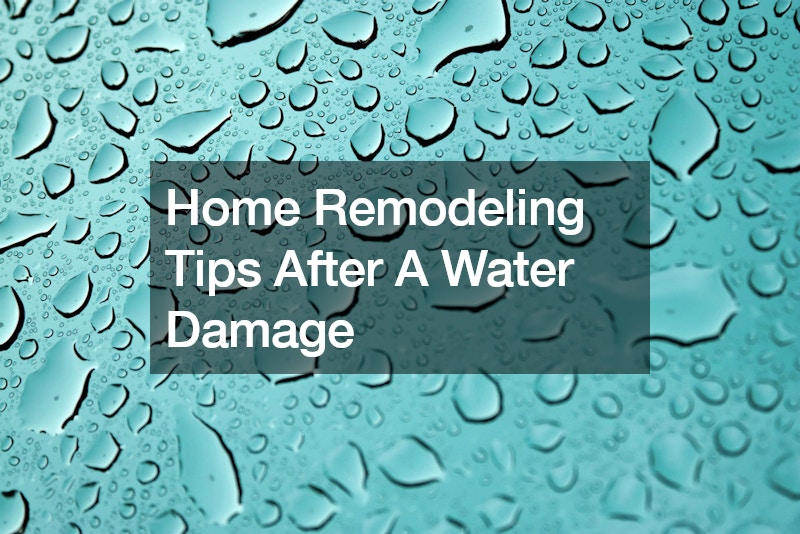Water damage can wreak havoc on your home, causing structural issues, mold growth, and destruction of belongings. Whether it’s from a burst pipe, flooding, or a leaky roof, recovering from water damage requires swift action and careful planning. However, amidst the chaos, there’s an opportunity to not only restore your home but also to upgrade and enhance its aesthetics and functionality. Here are some valuable tips for remodeling your home after experiencing water damage.
1. Assess the Damage: Before diving into any remodeling projects, assess the extent of the damage thoroughly. Identify areas that require immediate attention, such as structural repairs, mold remediation, and drying out saturated materials.
Consider hiring professional water damage restoration services to ensure a comprehensive assessment and proper mitigation of the damage.
2. Prioritize Safety: Safety should always be a top priority during the remodeling process, especially after water damage. Ensure that the electrical system is turned off in affected areas to prevent the risk of electrocution. Use personal protective equipment (PPE) such as gloves, masks, and goggles when handling damaged materials to minimize exposure to contaminants and mold.
3. Plan for Mold Remediation: Water damage often leads to mold growth, which can pose serious health risks if not addressed promptly. Include mold remediation in your remodeling plans by hiring certified professionals to inspect and remove mold-infested materials safely. Proper ventilation and moisture control measures should also be implemented to prevent future mold growth.
4. Consider Structural Repairs: Structural integrity may be compromised after water damage, requiring repairs to walls, floors, ceilings, and foundation. Work with experienced contractors or structural engineers to assess the extent of the damage and develop a plan for necessary repairs. Reinforcing vulnerable areas and ensuring proper drainage can help prevent future water-related issues.
5. Upgrade Plumbing and Waterproofing: Use the remodeling process as an opportunity to upgrade your home’s plumbing system and improve waterproofing measures. Replace old or damaged pipes, install leak detection devices, and seal cracks or gaps in walls and foundations to prevent future water leaks. Consider investing in water-resistant building materials for areas prone to moisture, such as bathrooms and basements.
6. Optimize Layout and Design: Take advantage of the remodeling process to optimize the layout and design of your home. Consider open-concept layouts, functional storage solutions, and energy-efficient features that enhance livability and reduce utility costs. Work with an experienced designer or architect to create a customized plan that meets your needs and preferences.
7. Choose Durable and Resilient Materials: Selecting durable and resilient materials is essential for long-term durability and maintenance after water damage. Choose flooring, countertops, and finishes that are resistant to water, mold, and moisture damage. Consider materials such as porcelain tile, vinyl plank flooring, and quartz countertops for their durability and ease of maintenance.
8. Invest in Proper Insulation: Adequate insulation is key to preventing future water damage and maintaining a comfortable indoor environment. Ensure that your home is properly insulated to regulate temperature and humidity levels, reducing the risk of condensation and moisture buildup. Insulate exterior walls, attics, and crawl spaces to improve energy efficiency and moisture control.
9. Maintain Proper Ventilation: Proper ventilation is crucial for preventing moisture buildup and promoting indoor air quality. Install exhaust fans in kitchens, bathrooms, and laundry rooms to remove excess moisture and odors. Consider adding a whole-house ventilation system to ensure adequate air circulation and ventilation throughout your home.
10. Work with Professional Contractors: Remodeling after water damage requires expertise and experience to ensure successful outcomes. Hire licensed and insured contractors who specialize in water damage restoration services and remodeling projects. Obtain multiple quotes, check references, and review past projects to find reputable professionals who can handle the job effectively.
Remodeling your home after water damage can be a challenging and complex process, but with careful planning and execution, you can restore and enhance your living space for years to come. By prioritizing safety, addressing structural issues, and investing in quality materials and professional services, you can transform your home into a resilient and beautiful sanctuary.
Remember to consider water damage restoration services as part of your remodeling plans to ensure a thorough and effective recovery from water-related issues. With the right approach and assistance, you can turn adversity into an opportunity to create the home of your dreams.
.






